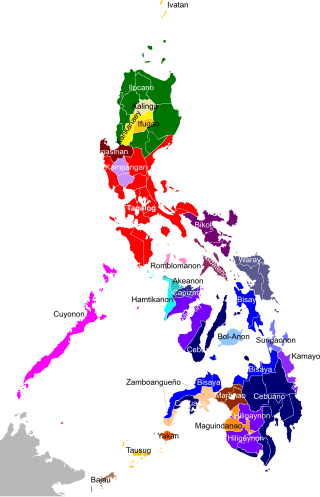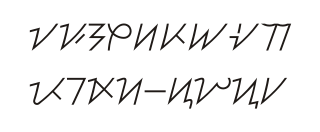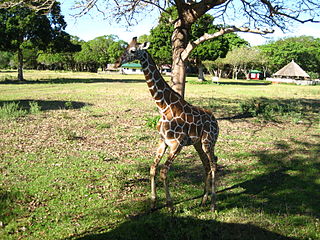The Tagbanwa are an ethnic group of Palawan, Philippines.
Tagbanwa may also refer to:
The Tagbanwa are an ethnic group of Palawan, Philippines.
Tagbanwa may also refer to:
Baybayin is a Philippine script. The script is an abugida belonging to the family of the Brahmic scripts. Geographically, it was widely used in Luzon and other parts of the Philippines prior to and during the 16th and 17th centuries before being replaced by the Latin alphabet during the period of Spanish colonization. It was used in the Tagalog language and, to a lesser extent, Kapampangan-speaking areas; its use spread to the Ilocanos in the early 17th century. In the 19th and 20th centuries, baybayin survived and evolved into multiple forms—the Tagbanwa script of Palawan, and the Hanuno'o and Buhid scripts of Mindoro—and was used to create the constructed modern Kulitan script of the Kapampangan and the Ibalnan script of the Palawan people. Under the Unicode Standard and ISO 15924, the script is encoded as the Tagalog block.

Coron is the third-largest island in the Calamian Islands in northern Palawan in the Philippines. The island is part of the larger municipality of the same name. It is about 170 nautical miles (310 km) southwest of Manila and is known for several Japanese shipwrecks of World War II vintage. Because of its unique ecological features, the entire area is protected by several legal proclamations.

Surat Buhid is an abugida used to write the Buhid language. As a Brahmic script indigenous to the Philippines, it closely related to Baybayin and Hanunó'o. It is still used today by the Mangyans, found mainly on island of Mindoro, to write their language, Buhid, together with the Filipino latin script.

Tagbanwa is one of the scripts indigenous to the Philippines, used by the Tagbanwa and the Palawan people as their ethnic writing system.

The Philippines is inhabited by more than 182 ethnolinguistic groups, many of which are classified as "Indigenous Peoples" under the country's Indigenous Peoples' Rights Act of 1997. Traditionally-Muslim peoples from the southernmost island group of Mindanao are usually categorized together as Moro peoples, whether they are classified as Indigenous peoples or not. About 142 are classified as non-Muslim Indigenous People groups, and about 19 ethnolinguistic groups are classified as neither indigenous nor moro. Various migrant groups have also had a significant presence throughout the country's history.

Palawan, the largest province in the Philippines, is home to several indigenous ethnolinguistic groups namely, the Kagayanen, Tagbanwa, Palawano, Taaw't Bato, Molbog, and Batak tribes. They live in remote villages in the mountains and coastal areas.

The kubing is a type of Philippine jaw harp from bamboo found among the Maguindanaon and other Muslim and non-Muslim tribes in the Philippines and Indonesia. It is also called kobing (Maranao), kolibau (Tingguian), aru-ding (Tagbanwa), kuribaw, aribao (Isneg), aroding (Palawan), kulaing (Yakan), ulibaw (Kalinga), karombi (Toraja), yori (Kailinese) or Kulibaw. Ones made of sugar palm-leaf are called karinta (Munanese), ore-ore mbondu or ore Ngkale (Butonese).

The Tagbanwa people are one of the oldest ethnic groups in the Philippines, and can be mainly found in the central and northern Palawan. Research has shown that the Tagbanwa are possible descendants of the Tabon Man, thus making them one of the original inhabitants of the Philippines. They are a brown-skinned, slim, and straight-haired ethnic group.
The Palawano languages are spoken in the province of Palawan in the Philippines, by the Palawano people.
The Kalamian languages are a small cluster of languages spoken in the Philippines: Calamian Tagbanwa and Agutaynen. Other languages called Tagbanwa, the Aborlan Tagbanwa language and Central Tagbanwa language are members of the Palawanic languages.
The Palawanic languages are a subgroup in the Greater Central Philippine-family spoken on the island of Palawan and nearby islets.

Hanunoo, also rendered Hanunó'o, is one of the scripts indigenous to the Philippines and is used by the Mangyan peoples of southern Mindoro to write the Hanunó'o language.

Calauit Island is an island of the Calamian Archipelago, just off the north-western coast of Busuanga Island. It is part of the municipality of Busuanga in the province of Palawan, Philippines. The entire island was declared as a wildlife sanctuary and game preserve in 1977, now is a tourist attraction known as Calauit Safari Park.
Calamian Tagbanwa is spoken in the Calamian Islands just north of Palawan Island, Philippines. It is not mutually intelligible with the other languages of the Tagbanwa people. Ethnologue reports that it is spoken in Busuanga, Coron, Culion, and Linapacan municipalities.
Aborlan Tagbanwa is spoken on Palawan Island in the Philippines. It is not mutually intelligible with the other languages of the Tagbanwa people.
Central Tagbanwa is spoken on Palawan Island in the Philippines. It is not mutually intelligible with the other languages of the Tagbanwa people.
Batak is an Austronesian language spoken by the Batak people on Palawan Island in the Philippines. It is sometimes disambiguated from the Batak languages as Palawan Batak.
Tagalog is a Unicode block containing characters of the Baybayin script, specifically the variety used for writing the Tagalog language before Spanish colonization of the Philippines eventually led to the adoption of the Latin alphabet. It has been a part of the Unicode Standard since version 3.2 in April 2002. Tagalog characters can be found in the Noto Sans Tagalog font, among others. The Tagalog Baybayin script was originally proposed for inclusion in Unicode alongside its descendant Hanunoo, Buhid and Tagbanwa scripts as a single block called "Philippine Scripts" and two punctuation marks are only part of the Hanunoo block. In 2021, with version 14.0, the Unicode Standard was updated to add three new characters: the "ra" and archaic "ra", and the pamudpod.
Kalamian may refer to:
Suyat is the modern collective name of the indigenous scripts of various ethnolinguistic groups in the Philippines prior to Spanish colonization in the 16th century up to the independence era in the 21st century. The scripts are highly varied; nonetheless, the term was suggested and used by cultural organizations in the Philippines to denote a unified neutral terminology for Philippine indigenous scripts.